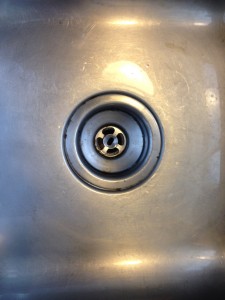 Sometimes something might not seem right. Maybe you pitched your yeast yesterday and now there’s a funny smell coming from your airlock. Maybe there’s something floating on top of your wort after the yeast have flocculated. At some point, most homebrewers have worried that something is amiss with one of their beers. The question then becomes — should I dump it?
Sometimes something might not seem right. Maybe you pitched your yeast yesterday and now there’s a funny smell coming from your airlock. Maybe there’s something floating on top of your wort after the yeast have flocculated. At some point, most homebrewers have worried that something is amiss with one of their beers. The question then becomes — should I dump it?
In most cases, the best answer is no, wait and see. There are many reasons why something may seem unusual to you, but not be an actual problem. Let’s take a look at some common things that frequently lead brewers — and especially beginning brewers — to suspect something is wrong and see what their response should be.
Something Looks Suspicious
Glass carboys are great. You can see your beer as it ferments and this is a good thing — until you see something unusual in your latest batch. If you read online brewing forums, you will frequently see brewers submitting photos of their beers and asking if their beer is contaminated. (Actually, they’re more likely to ask if it’s infected, although that isn’t the best word choice.) Most of the time, they are worrying about nothing.
Fermentations can look very different. Different yeast strains perform differently. Some fermentations result in uniformly cloudy wort. Other result in globs of yeast churning in a carboy of fairly clear wort. Some fermentations produce large, rocky layers of kräusen atop the fermenting beer. Others result in a light layer of foam. Yeast may clump together or not, and it may appear anywhere between white and brown. Sometimes, even after the rest of the yeast has flocculated, a few “floaties” will be left behind.
Unless you have used a particular yeast strain before and are absolutely sure something is wrong, don’t dump a fermenting batch of beer because something looks wrong. Let it finish and condition and everything will probably be alright.
If you see something floating atop your wort or beer that is brightly colored (especially yellow or red), this is likely an unwanted bacterial contaminant. Likewise, if there’s a floating “island” in your fermenter and it looks filamentous (“hairy,” like bread mold), this is likely an unwanted fungus and is cause for concern. Such contaminants are rare, though.
Something Smells Suspicious
Just as fermentations can look very different, they can also smell very different. Some fermentations may smell like fresh wort part of the time. Other fermentations may emit pungent odors that make you recoil. Different yeast strains give off different fermentation byproducts and these also vary with fermentation conditions. Unless you have a lot of experience with a given yeast strain, do not worry that the gas coming from your fermentation lock smells funny. It may be perfectly normal for that yeast at that stage of the fermentation. Some lager strains, for example, are notorious for producing a strong sulfur smell during fermentation. This has led some first-time lager brewers to worry they were brewing beer that would taste like rotten eggs.
Unless you have a lot of experience with a given yeast strain, don’t worry about strange odors coming out of your airlock. This is especially true if you have no other reasons to suspect something is amiss. And also, remember that it you smell an unpleasant odor coming from your airlock, that odor is being expelled from your beer during fermentation. It doesn’t mean your beer will smell or taste like that. In addition to unpleasant odors being “outgassed” during fermentation, yeast also “clean up” the flavors and aromas of green beer during conditioning. So, if you smell something odd coming from your fermentation lock, make a note of it your brewing notebook, but realize that your beer is probably fine.
I’ll post the conclusion to this piece on Monday.
—
Related Article

Speak Your Mind